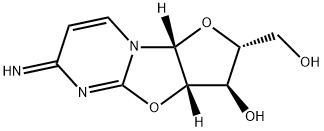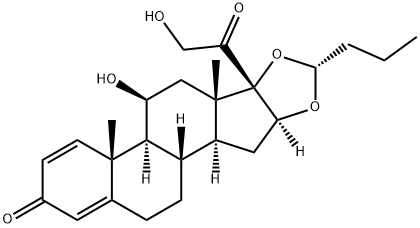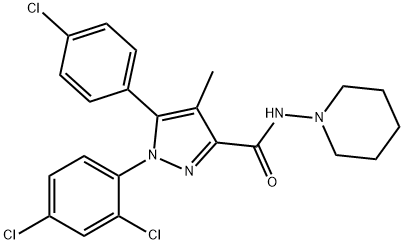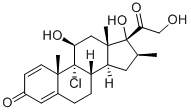AMCINONIDE
- CAS NO.:51022-69-6
- Empirical Formula: C28H35FO7
- Molecular Weight: 502.57
- MDL number: MFCD00213379
- EINECS: 256-915-2
- SAFETY DATA SHEET (SDS)
- Update Date: 2025-12-26 08:49:36

What is AMCINONIDE?
Absorption
Topical corticosteroids can be absorbed from normal intact skin. Inflammation and/or other disease processes in the skin increase percutaneous absorption.
Toxicity
Results from acute toxicity studies do not indicate that any risk of acute intoxication is to be expected following a single dermal application of an overdose (application over a large area under conditions favorable to absorption) or inadvertent oral ingestion.
Originator
Cyclocort,Lederle,US,1979
The Uses of AMCINONIDE
Glucocorticoid.
The Uses of AMCINONIDE
antiinflammatory
What are the applications of Application
Amcinonide is a Corticosteroid
Background
Amcinonide is a corticosteroid.
Indications
For the relief of the inflammatory and pruritic manifestations of corticosteroid-responsive dermatoses.
Definition
ChEBI: Amcinonide is a corticosteroid, an 11beta-hydroxy steroid, a fluorinated steroid, a 20-oxo steroid, an acetate ester, a spiroketal and a 3-oxo-Delta(1),Delta(4)-steroid. It has a role as an anti-inflammatory drug. It derives from a hydride of a pregnane.
Manufacturing Process
An 11.1 g (24.1 mmol) portion of the compound 16α,17α- cyclopentylidenedioxy-9α-fluoro-11β,21-dihydroxy-1,4-pregnadiene-3,20-dione is placed in a 250 ml round-bottom flask. A 100 ml portion of pyridine is added and the mixture is stirred to a complete solution. A 5.5 ml (54.6 mmol) portion of acetic anhydride is added dropwise and the mixture is stirred for 2% hours. An 11 ml portion of methanol is added and the mixture is stirred an additional hour. This mixture is concentrated under reduced pressure to about 10 to 15 ml and then poured slowly into a mixture of ice, water and dilute hydrochloric acid. This mixture is stirred and the solid which forms is collected by filtration, washed with water to a neutral pH and air dried yielding 11.5 g. This solid is taken up in hot acetone, treated with activated charcoal and filtered while hot through diatomaceous earth. The filtrate is concentrated on a steam bath while adding n-hexane to the point of incipient crystallization. This mixture is allowed to cool to room temperature. The solid which forms is collected by filtration, washed with acetone-n-hexane (1:14) and air dried yielding 7.0 g of the desired product.
brand name
Cyclocort (Astellas.
Therapeutic Function
Topical corticosteroid, Antiinflammatory
General Description
Amcinonide, 21-(acetyloxy)-16α,17-[cyclopentylidenebis(oxy)]-9-fluoro-11β-hydroxypregna-1,4-diene-3,20-dione (Cyclocort).
Pharmacokinetics
Amcinonide is a topical corticosteroid. The topical corticosteroids constitute a class of primarily synthetic steroids used as anti-inflammatory and antipruritic agents. Amcinonide reduces or inhibits the actions of chemicals in the body that cause inflammation, redness, and swelling. The mechanism of anti-inflammatory activity of the topical corticosteroids is unclear. Various laboratory methods, including vasoconstrictor assays, are used to compare and predict potencies and/or clinical efficacies of the topical corticosteroids. There is some evidence to suggest that a recognizable correlation exists between vasoconstrictor potency and therapeutic efficacy in man. When in an ointment form, amcinonide also helps the skin maintain moisture.
Metabolism
Once absorbed through the skin, topical corticosteroids are handled through pharmacokinetic pathways similar to systemically administered corticosteroids. Corticosteroids are metabolized primarily in the liver and are then excreted by the kidneys.
Properties of AMCINONIDE
| Melting point: | >216°C (dec.) |
| Boiling point: | 635.9°C (rough estimate) |
| Density | 1.33±0.1 g/cm3 (20 ºC 760 Torr) |
| refractive index | 1.5860 (estimate) |
| storage temp. | -20°C Freezer |
| solubility | Acetonitrile (Slightly), Dichlomethane (Slightly), Dioxane (Slightly), Methanol |
| form | neat |
| pka | 13.09±0.70(Predicted) |
| form | Solid |
| color | White to Off-White |
Safety information for AMCINONIDE
Computed Descriptors for AMCINONIDE
New Products
4,4-Difluoropiperidine hydrochloride tert-butyl 9-methoxy-3-azaspiro[5.5]undecane-3-carboxylate Indole Methyl Resin N-Isopropylurea N,N-Dicyclohexylcarbodiimide(DCC) MELDRUMS ACID 5-METHYLISOXAZOLE-4-CARBOXYLIC ACID Magnessium Bis glycinate Zinc ascorbate 1-bromo-2-butyne 2-acetamidophenol 9(10H)-anthracenone Erythrosin B, 4-Piperidinopiperidine 2-((4-morpholinophenylamino) (methylthio) methylene) malononitrile 2,4-dihydroxybenzaldehyde 3-(4-morpholinophenylamino)-5-amino-1H-pyrazole-4-carbonitrile Methyl 2-methylquinoline-6-carboxylate 2,6-dichloro-4-nitropyridine 4-Bromo-2-chlorobenzonitrile 2-(benzylamino)acetic acid hydrochloride 4-(tert-Butoxycarbonylamino)but- 2-ynoic acid 3,4-dihydro-2H-benzo[b][1,4]dioxepine 1-Phenyl-1-cycloprppanecarboxylicacidRelated products of tetrahydrofuran








You may like
-
 Amcinonide 99%View Details
Amcinonide 99%View Details -
 Amcinonide CAS 51022-69-6View Details
Amcinonide CAS 51022-69-6View Details
51022-69-6 -
 3-(4-amino-1-oxoisoindolin-2-yl)-1-methylpiperidine-2,6-dione 98%View Details
3-(4-amino-1-oxoisoindolin-2-yl)-1-methylpiperidine-2,6-dione 98%View Details -
 614-19-7 98%View Details
614-19-7 98%View Details
614-19-7 -
 20677-73-0 (2,2-diethoxyethyl)methylamine 98%View Details
20677-73-0 (2,2-diethoxyethyl)methylamine 98%View Details
20677-73-0 -
 3-(4-(hydroxyamino)-1-oxoisoindolin-2-yl)piperidine-2,6-dione 98%View Details
3-(4-(hydroxyamino)-1-oxoisoindolin-2-yl)piperidine-2,6-dione 98%View Details -
 57381-49-4 2-bromo-4-chlorobenzonitrile 98%View Details
57381-49-4 2-bromo-4-chlorobenzonitrile 98%View Details
57381-49-4 -
 4,6-dichloropyrimidine-5-carbaldehyde 98%View Details
4,6-dichloropyrimidine-5-carbaldehyde 98%View Details
5305-40-8
